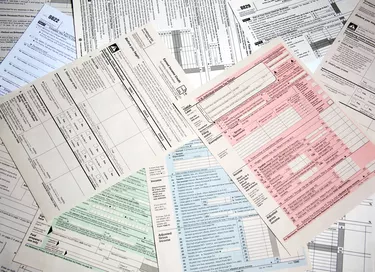
Putting together the documents for your tax return before mailing them is a fairly simple task. But if you mess up one piece of the process, you could delay your return's processing, get your refund later or, worse, you might end up getting your submission rejected and end up filing late and accruing late-filing penalties. Reviewing what to send with paper tax returns and how to submit your filing will help you avoid any problems.
Read More: How to Attach W-2s to Tax Returns
Video of the Day
Video of the Day
Reviewing What Documents You’re Submitting
If your submission isn't very complex, you might simply be attaching a Form W-2 or Form 1099 to a Form 1040. If you're itemizing and/or submitting business deductions, you might be including a Schedule A or C.
Make sure you write a checklist of the documents you'll be submitting so you can check each item off your list as the final step before you put your mailing into an envelope. Check the IRS website for more information on getting the forms you need.
If you did more than $600 worth of contract work during the year for a business and didn't receive a 1099 by January 31, contact the business to see if they are sending you a 1099. Let them know you haven't received it by the required IRS deadline. If they tell you they are not required to send you a 1099, you can check with a tax professional to make sure.
Submit the Correct Forms
If you receive a W-2 from an employer or a 1099 from a business you did contract work for, you'll receive three copies. One is for you, one is for the IRS and one is for your state (if you pay state income tax). While you can submit any one of the three forms to the IRS without penalty, take the time to submit the correct copy to the IRS and your state by looking at the forms to see which copy is which.
If you are itemizing or claiming business deductions, make sure you use either Schedule A or Schedule C. Talk to a tax professional to see whether you need to file any other state or federal forms, based on your filing status, the number of exemptions you're claiming or the types of deductions you're claiming.
Look for Directions on Documents
Look at the top, right-hand side of the first page of each form you plan on submitting. It will have a sequence number to help you place your forms in order. In addition to sequence numbers, your documents will show you where they need to be signed and dated. You might also need to add other information, including your address, Social Security number and the name of your business, your title and the business structure, if you are a business owner.
Fill Out Your Check
If you're paying with a paper check, fill out the check as you normally would. The IRS requests that you write on the check your name, address, daytime phone number, Social Security or Employer Identification Number along with the tax year for which you are filing.
This is very important. If you have an installment plan, for example, and still owe money from previous years, if your check gets separated from your tax forms and it has no tax year on it, your check might be applied to your prior year installment. Because the IRS requests that you not attach your payment to your forms, checks are more likely to be separated from their packets.
Read More: What Happens if You Don't File Taxes?
Prepare the Packet
Visit the IRS website and read the document, "How to Prepare Your Tax Return for Mailing." If you're an individual filing a basic tax return, paper clip or staple your W-2 or 1099 to the top, left-hand side of your 1040. Give the people who take tax forms out of their envelopes and prep them for auditors a break by not using a staple – paper clips are easier to quickly remove and they don't puncture the skin on fingers.
Put your 1040 on top of any other forms you are using, placing the other forms in their correct sequence. Put your documents in your envelope and seal the envelope.
How to Send Your Return
You can send your tax return to the IRS using a private delivery service or the U.S. Postal Service. Use an official IRS pre-addressed envelope or one provided by your state. You are responsible for adding the correct amount of postage if you use the USPS. If you take it to the post office, you can get tracking or a recipient signature using certified or registered mail.
Make sure you have the proper mailing and return address on the envelope. Submit your mailing to be postmarked or date by April 15 (or next business day if this date is a holiday or weekend day) or your extension date.